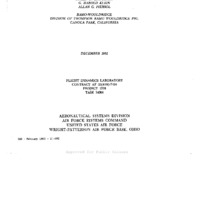-
Title
-
The Application Of Statistics To The Flight Vehicle Vibration Problem
-
Description
-
This report presents a critical analysis of the application of statistics to flight vehicle vibration problems. The general problem is discussed from many aspects, and results are applicable to many other physical areas besides vibration. Detailed analytical engineering procedures are proposed for determining statistical properties of a single vibration record, and for establishing the over-all vibration environment from a collection of vibration records. Jet aircraft and several categories of missiles are broken down into definite operating phases as regards their vibration environment. Simple statistical techniques are developed for reducing the amount of data that needs to be gathered for lateer processing. This technique can provide a low probability of missing an unexpected event, and a high probability of covering the range of expected events. Straight-forward statistical tests are developed for testing fundamental assumptions and randomness, stationarity, and normality. Mathematical and physical distinctions are explained between different information obtained by measuring numerous important statistical parameters, such as an instantaneous amplitude probability density function, or a mean square autocorrelation function. An engineering discussion is given of related instrumentation equipment available today in many laboratories, with emphasis on their statistical accuracy in measuring desired information. An experimental laboratory and flight test program is outlined for verifying these measurement accuracies and other theoretical statistical results contained in the report, such as material on repeated experiments and random sampling techniques. Important physical applications are explored indicating how statistical information can be helpful in predicting the response of continuous structures to random excitation, and for evaluating loading effects on a structure. The report concludes with recommendations for future work.
-
Date
-
1961
-
Index Abstract
-
Contrails and DTIC condensed and truncated
-
Photo Quality
-
Not Needed
-
Report Number
-
ASD TR 61-123
-
Creator
-
Bendat, Julius S.
-
Enochson, Loren D.
-
Corporate Author
-
Thompson Ramo Wooldridge Inc Canoga Park Calif
-
Laboratory
-
Aeronautical Systems Division
-
Extent
-
534
-
Identifier
-
AD0271913
-
AD0271913
-
Access Rights
-
OTS
-
Distribution Classification
-
1
-
Contract
-
AF 33(616)-7434
-
DoD Project
-
1370
-
DoD Task
-
14004
-
DTIC Record Exists
-
Yes
-
Distribution Change Authority Correspondence
-
None
-
Date Modified
-
Scanned by request 10/22/2007 submitted by a Private Citizen (No Known Affiliation)
-
Abstract
-
This report presents a critical analysis of the application of statistics to flight vehicle vibration problems. The general problem is discussed from many aspects, and results are applicable to many other physical areas besides vibration. Detailed analytical engineering procedures are proposed for determining statistical properties of a single vibration record, and for establishing the over-all vibration environment from a collection of vibration records. Jet aircraft and several categories of missiles are broken down into definite operating phases as regards their vibration environment. Simple statistical techniques are developed for reducing the amount of data that needs to be gathered for lateer processing. This technique can provide a low probability of missing an unexpected event, and a high probability of covering the range of expected events. Straight-forward statistical tests are developed for testing fundamental assumptions and randomness, stationarity, and normality. Mathematical and physical distinctions are explained between different information obtained by measuring numerous important statistical parameters, such as an instantaneous amplitude probability density function, or a mean square autocorrelation function. An engineering discussion is given of related instrumentation equipment available today in many laboratories, with emphasis on their statistical accuracy in measuring desired information. An experimental laboratory and flight test program is outlined for verifying these measurement accuracies and other theoretical statistical results contained in the report, such as material on repeated experiments and random sampling techniques. Important physical applications are explored indicating how statistical information can be helpful in predicting the response of continuous structures to random excitation, and for evaluating loading effects on a structure. The report concludes with recommendations for future work.
-
Report Availability
-
Full text available
-
Date Issued
-
1961-12
-
Provenance
-
Lockheed Martin Missiles & Fire Control
-
Type
-
report
-
Format
-
1 online resource (xix, 518 pages) : ill.
-
Subject
-
Shells (Structural Forms)
-
Airframes
-
Vibration
-
Test Methods
-
Test Equipment
-
Airfoils
-
Reliability
-
Mathematical Prediction
-
Cylindrical Bodies
-
Vibrators (Mechanical)
-
Sheets
-
Resonance
-
Artificial Satellites
-
Fatigue (Mechanics)
-
Statistical Analysis
-
Failure (Mechanics)
-
Test Facilities
-
Manned
-
Aircraft Panels
-
Jet Aircraft
-
Life Expectancy (Service Life)
-
Spacecraft
-
Guided Missiles
-
Mathematical Analysis
-
Publisher
-
Wright-Patterson Air Force Base, OH : Aeronautical Systems Division, Air Force Systems Command, United States Air Force
 ASDTR61-123.pdf
ASDTR61-123.pdf